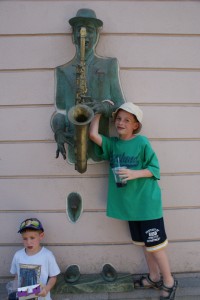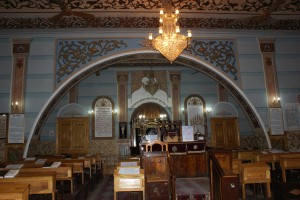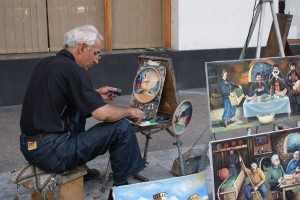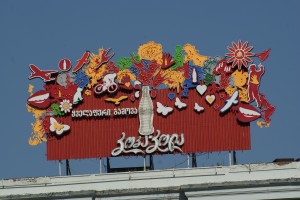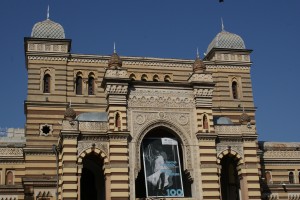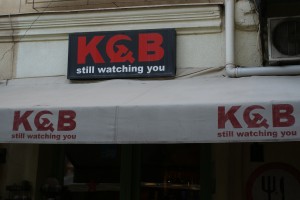Tbilisi is one of those cities that mesmerizes the imagination. It is an ancient city, a city at the crossroads of East and West, and a city that has been wrestled over by rival powers over the millennia. Tbilisi is by far the largest city in Georgia and Georgians from all over the country make their way to Tbilisi – to seek their fortunes, to escape poverty and to experience the big city. It really is the only city in Georgia (apart from Batumi on a much smaller scale) that is at all cosmopolitan and outwards looking.
Tbilisi is very attractive – it is built on a number of hills, and many hilltops are crowned with impressive buildings – golden domed churches, an ancient castle, huge statues, and even a candy-cane like TV tower. A river runs through the city centre, and there is both a very ancient part and a modern part. We would be exploring as much as possible.
Tbilisi is well endowed with good Western hotels – a couple of Marriotts, a Sheraton, a Radisson, as well as many cheaper hotels and guesthouses. But we were staying in an apartment which I had managed to rent through a Tbilisi travel contact. The taxi took us to the address, which was in the city center, very close to McDonald’s (more about this later) and most of the attractions of the modern part of the city.
We were welcomed by Rusiko, a medical doctor whose family owns a large property near the city centre – it was basically an old house, subdivided into about 4 or 5 different apartments. Ours would be on the 2nd (and top) floor – we had two good-sized bedrooms, a lounge and a kitchen, with our own washing machine. Outside in the garden, there was a plastic inflatable swimming pool for the kids and a tortoise roaming free, which we had to search for. All in all we had plenty of space – the only drawback being the air conditioner that was not really powerful enough to handle the whole apartment. We were in a fantastic locality – within walking distance of the main shopping street of Tbilisi (Rustaveli), and the Metro. We had two supermarkets nearby as well.
After relaxing and cleaning up, it was time to explore.
Our plan for the day was to stroll down Rustaveli – the central boulevard of the modern city. Rustaveli was laid out by the Russians in the late 19th century, and is flanked on either side by hugely impressive buildings – from the national museum to the theatre, opera house and houses of parliament. On closer inspection we would see that many of these grand buildings are currently closed – either they are being renovated or they are being transformed into luxury hotels. But from afar they are very special.
We had learned in Batumi that Georgians take their statues very seriously, and Tbilisi is no exception – huge, extravagant sometimes – statues are everywhere and proclaim the greatness of heroes in fact and legend. Georgia is named after St George (of the dragon fame) and a huge statue dominates the central traffic circle.
We passed an internet cafe and English bookstore – both very important to us – and were interested to see a mix of fancy boutiques, cafes and banks. Clearly, Tbilisi is striving to look and feel like Europe. The city centre is not big, and we walked into the Old City – a narrow patchwork of tiny lanes, ancient churches and pubs, everywhere. Eventually we reached the bathhouse district. Tbilisi was founded due to the presence of hot springs and the city has famous bath houses where the people have enjoyed the hot springs for centuries I was hoping that we would have a bath here, but the appeal wore off in the 40 degrees celcius heat – the idea of a hot sulphurous bath just didn’t work for us.
Georgians have historically been very open-minded of other cultures and religions – in the bathhouse district we visited the synagogue, which was next to some huge churches on the one side and a mosque on the other. We went into churches that seemed to come straight out of a Dan Brown novel – dark, smoky, chanting, filtered sunlight, staring icons…incredible. Georgians seem to bear no animosity to other religions – in fact, the Georgians regard themselves as a persecuted people. Through the ages, Christian Georgia was wedged in between the Islamic Ottoman and Persian Empires (Turkey and Iran) and Georgians periodically suffered tremendously at the hands of these neighbours. It was the reason that the Georgian kings eventually turned to Russia for protection, and how Georgia became a Russian satellite.
Tbilisi is a quirky city – lots of interesting little sculptures everywhere that the kids enjoyed playing with, and we even found a Pizzeria with a huge Chelsea flag – Chelsea being our family’s favourite soccer team. We simply wandered about – taking in as much as we could of this absolutely fascinating city. One can watch the street life for hours.
For food, we found a chain of restaurants called Shemoikhede Genatsvale – impossible to pronounce as with almost all Georgian words, which specialise in Georgian food, but more importantly, had at least on person on staff who could speak English. Also, they had an English menu!! This was a big win for us, and guaranteed that we would become regulars.
By the end of the day, it was back to “home”.
PS: These days I am helping families plan great trips to destinations on five continents. Click here for more info.
